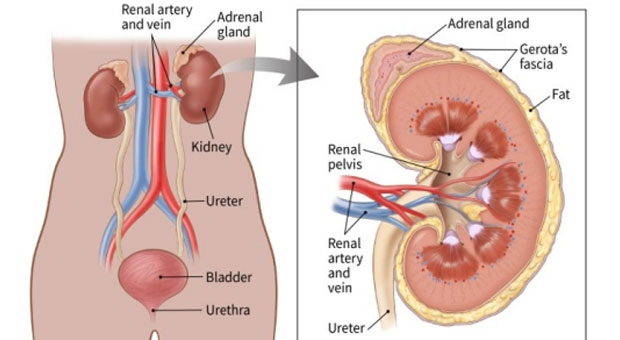
Kidney cancer is cancer that originates in the kidneys. Your kidneys are two bean-shaped organs, each about the size of your fist. They’re located behind your abdominal organs, with one kidney on each side of your spine. In adults, the most common type of kidney cancer is renal cell carcinoma. Other less common types of kidney cancer can occur. Young children are more likely to develop a kind of kidney cancer called Wilms’ tumor.
The incidence of kidney cancer seems to be increasing, though it’s not clear why. Many kidney cancers are detected during procedures for other diseases or conditions. Imaging techniques such as computerized tomography (CT) are being used more often, which may lead to the discovery of more kidney cancers.
Causes
It’s not clear what causes renal cell carcinoma. Doctors know that kidney cancer begins when some kidney cells acquire mutations in their DNA. The mutations tell the cells to grow and divide rapidly. The accumulating abnormal cells form a tumor that can extend beyond the kidney. Some cells can break off and spread (metastasize) to distant parts of the body.
Uro-oncology
Uro-oncology is the most advanced and rapidly growing branch of urology that deals with the cancers of urinary tract and male sexual system. Dr Neeraj Goyal is expert uro-oncologist providing evidence based latest treatment for all urological cancers. The different urological cancers and their treatments include:
Kidney Cancer
Kidney cancer is a very common cancer after the age of 60 years and its incidence is on the rise due to various environmental risk factors, smoking, changing dietary habits, obesity and smoking. The treatments offered by Dr Neeraj Goyal for kidney cancer include:
- Laparoscopic Radical Nephrectomy:
Removal of the entire kidney with its surrounding fat and various covering layers as a single packet for very large kidney cancers that affect most of the kidney area. A well-performed laparoscopic radical nephrectomy in expert hands is curative most of the times and can lead to permanent cure in selected patients.
- Laparoscopic Partial Nephrectomy:
Partial nephrectomy involves removal of the tumour or cancer bearing area of the kidney and preserves rest of the normal kidney tissue. It is the surgery of choice for patients having small kidney cancers that are restricted to a particular area of kidney. In properly selected patients it can be completely curative with advantage of saving a portion of the kidney.
- Radical Nephrectomy with IVC tumor Thrombectomy:
This is a highly advanced and skilled surgery which is performed for advanced kidney cancers that have progressed to involve the inferior vena cava (the largest blood vessel that returns the blood from the lower half of body back to heart). A well-performed surgery can completely remove the cancerous tissue from the body and can possibly cure the disease if it has not spread to other distant organs.
Urinary Bladder Cancer
The bladder is a hollow muscular organ in your lower abdomen that stores urine and evacuates it at the time of urination. Bladder cancer is a common type of cancer that begins in the cells of urinary bladder. Bladder cancer most often begins in the cells (urothelial cells) that line the inside of your bladder.
Most of the bladder cancers are diagnosed at an early stage because they often cause hematuria (appearance of blood in urine) at an early stage, when the cancer is highly treatable. But even early-stage bladder cancers can come back after successful treatment. For this reason, people with bladder cancer typically need follow-up tests for years after treatment to look for bladder cancer reappearance.
Risk factors for occurrence of bladder cancer:
- Smoking:
Cigarette smoking may increase the risk of bladder cancer and is the most common cause of this cancer in India.
- Increasing age:
Bladder cancer risk increases as you age. Though it can occur at any age, most people diagnosed with bladder cancer are older than 55.
- Being male:
Men are more likely to develop bladder cancer than women are.
- Exposure to certain chemicals:
Chemicals linked to bladder cancer risk include arsenic and chemicals used in the manufacture of dyes, rubber, leather, textiles and paint products.
- Previous cancer treatment:
Treatment with the anti-cancer drug cyclophosphamide increases the risk of bladder cancer. People who received radiation treatments aimed at the pelvis for a previous cancer have a higher risk of developing bladder cancer.
- Chronic bladder inflammation:
Chronic or repeated urinary infections or inflammations (cystitis), such as might happen with long-term use of a urinary catheter, may increase the risk of a squamous cell bladder cancer. In some areas of the world, squamous cell carcinoma is linked to chronic bladder inflammation caused by the parasitic infection known as schistosomiasis.
- Personal or family history of cancer:
If you’ve had bladder cancer, you’re more likely to get it again. If one of your blood relatives — a parent, sibling or child — has a history of bladder cancer, you may have an increased risk of the disease, although it’s rare for bladder cancer to run in families.
Bladder cancer surgery
Surgeries to treat bladder cancer include:
- Transurethral resection of bladder tumor (TURBT) :
TURBT is a procedure to diagnose bladder cancer and to remove cancers confined to the inner layers of the bladder — those that aren’t yet muscle-invasive cancers. During the procedure, a surgeon passes an electric wire loop through a cystoscope and into the bladder. The electric current in the wire is used to cut away or burn away the cancer. Alternatively, a high-energy laser may be used.
Because doctors perform the procedure through the urethra, you won’t have any cuts (incisions) in your abdomen. - Radical Cystectomy:
Cystectomy is surgery to remove all or part of the bladder. During a partial cystectomy, your surgeon removes only the portion of the bladder that contains a single cancerous tumor.
A radical cystectomy is an operation to remove the entire bladder and the surrounding lymph nodes. In men, radical cystectomy typically includes removal of the prostate and seminal vesicles. In women, radical cystectomy may involve removal of the uterus, ovaries and part of the vagina. Radical cystectomy can be performed through an incision on the lower portion of the belly or with multiple small incisions using laparoscopic surgery. - Neobladder reconstruction:
After a radical cystectomy, your surgeon must create a new way for urine to leave your body (urinary diversion). One option for urinary diversion is neobladder reconstruction.
A sphere-shaped reservoir out of a piece of your intestine is created. This reservoir, often called a neobladder, sits totally inside your body and is attached to your urethra. The neobladder allows most people to urinate normally. A small number of people difficulty emptying the neobladder and may need to use a catheter periodically to drain all the urine from the neobladder. - Ileal conduit:
For this type of urinary diversion, your surgeon creates a tube (ileal conduit) using a piece of your intestine. The tube runs from your ureters, which drain your kidneys, to the outside of your body, where urine empties into a pouch (urostomy bag) you wear on your abdomen.




